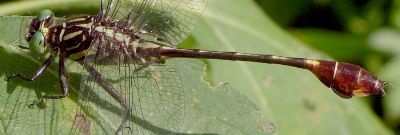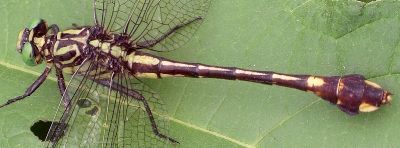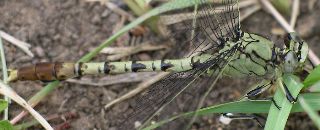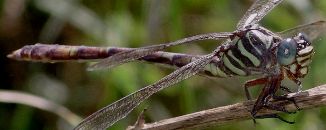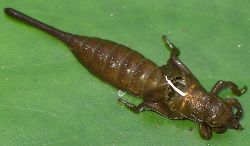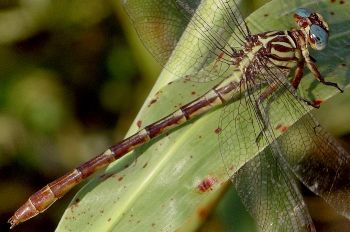
| Gomphidae ~ Clubtails |
|
The clubtails are named for the widened end of the abdomen common on many species, especially males. These are large dragonflies, usually found perching in trees or shrubs instead of on the ground. They tend to rest horizontally, but sometimes drop their abdomen downwards or hold it up. Their eyes are separated at the top, wings rarely have any color on them, and they are usually marked in camouflage colors, such as shades of brown, yellow and pale green, rather than bright ones. Unlike many other kinds of dragonflies, the eyes of the clubtails are separated at the top instead of touching. Most species are not particularly common.
Probably the species I see most often is the Eastern Ringtail (Erpetogomphus designatus), but it only shows up for a short time each year. The abdomen is distinctly ringed in both male and female, with the flared tip of the male being a rusty orange color. The female has almost no widening of the abdomen tip. Eyes are gray and the thorax is green with brown markings.
Males and females of the Cobra Clubtail (Gomphus vastus) are very similar in shape, both having a widely flared abdomen tip. They have green eyes and nearly black bodies with very light green markings. The markings on the abdomen tip are the easiest way to recognize the species and the genders. There are a pair of yellow marks on the sides towards the rear; on the female these are very distinct against a dark brown background color and on the male they are more blended into the reddish brown tail. The Jade Clubtail (Arigomphus submedianus) has an appropriate name for its color. I've only seen the male and the tip of the abdomen is barely flared at all. It is brown, with a pale tip. The general green color of the thorax and abdomen has relatively few black markings, with legs that turn black towards the tips. The eyes are gray. This is the only clubtail I've ever seen perched near the ground; it was probably not feeling very well.
Another species for which I've only seen one sex is the Broad-striped Forceptail (Aphylla angustifolia). The female has no flare at the tip, and the abdomen is brown and greenish, with vague markings. The thorax, however, has strong
The Broad-striped Forceptail has a very unique looking larva, as shown by the exuviae (molted larval skin) in the accompanying photo. The very elongate back end is an adaptation to life in soft mud. Dragonfly nymphs breath by forcing water through their bodies (and they also can jet propel by the same method) so they must have access to clear water. The long tail acts as a straw so that the nymph can hide in the mud and still breathe.
The female Four-striped Leaftail (Phyllogomphoides stigmatus) is another clubtail without much of a club at the end of the abdomen. There is a slight bit of widening, though, and males do have a club. The common name comes from the number of dark stripes on the side of the thorax. However, these are often rather difficult to see, depending on how the dragonfly is holding its wings. The abdominal markings provide good characteristics, with the strong light colored bands between mostly black large bands.
Rather common for a short time during the summer, the Russet-tipped Clubtail (Stylurus plagiatus) is not too hard to identify from a distance because of the rust-colored tail, especially on males. The female is a bit more difficult, as the abdomen is not as distinctively colored and flared only slightly. As with many clubtails, the main body colors are pale green and dark brown. The thorax has strong stripes and the eyes are a lovely shade of blue. |
![]()


